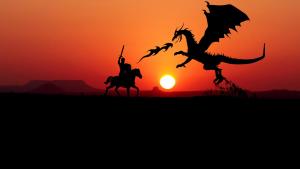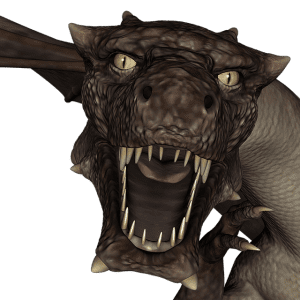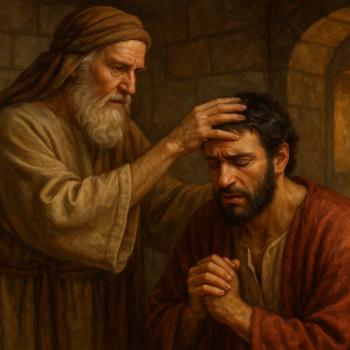Appropriate for horror film and Halloween enthusiasts alike are the monsters and scary people that we find in the Bible. Here are my top 12 picks:

12. The first zombie?
In 2 Kings 13:20–21, the prophet Elisha died and was buried in a tomb. Some time later, when some men were burying another man, they saw a band of enemy Moabites coming. So they quickly threw the corpse into Elisha’s tomb, and when the corpse of the man touched the bones of Elisha, it revived and stood on its feet. Nothing is written about whether the man stayed alive after this event or fell back down dead. The good news is that there is no evidence that he ate anyone!
Actually, the point of this narrative has nothing to do with zombies. It is to highlight the miraculous power of God through the prophet Elisha, who could even raise the dead. Some would also suggest this text may function as sort of a prelude to future resurrection.
11. A gigantic eyeball
In 1 Corinthians 12, Paul describes believers as members of the metaphorical body of Christ. Members of the body need other members, and everyone has their special ability and place. Otherwise, Paul humorously claims, “if the whole body were an eye, where would the hearing be?” (1 Corinthians 12:17). He prompts his readers to imagine how strange it would be for a body to resemble one huge eye!
It so happens that the people of Corinth erected a sanctuary dedicated to Asclepius, the god of healing. Devotees dedicated replicas of human body parts which they believed the god healed, whether a foot, arm, eyes, genitals, etc. But it is not clear if this sanctuary—old even in Paul’s day—would still be around and its body parts on display when Paul wrote 1 Corinthians. If the parts were still publicly visible, then Paul’s metaphor would be backed by a great visual that repeatedly reminded the Corinthians of the importance of being one body with diverse members in Christ.
10. Behemoth
This giant beast is said to be “the first of the ways of God.” It has power in its loins, and its limbs are as bars of iron, among other things (Job 40:15–24). Some speculate on whether the brute is supposed to resemble a dinosaur or is simply poetic hyperbole describing a large creature like a mammoth or hippopotamus. The text’s colorful language may suggest the latter. If so, there’s nothing much to be frightened about, unless you happen to get in its way! Other traditions, though, attach apocalyptic implications on this creature and team it up with the fearsome Leviathan (1 Enoch 60; 4 Ezra 6:49–52; 2 Baruch 29:3–4).
9. A witch and a ghost
In 1 Samuel 28, we find the story of King Saul consulting a medium from the town of En-dor. The Message Bible calls her a “witch of Endor” (1 Sam 28:7). Saul was distraught as an upcoming battle with the Philistines became imminent, and he heard no word from the Lord. His desperation drove him to violate the Law of Moses that prohibited necromancy—he seeks out this woman and requests that she conjure up the dead Prophet Samuel’s spirit. This way he might hear the word of the Lord!
The spooky thing about this narrative is that “Samuel” does appear, even to the medium’s surprise as she screams (1 Sam 28:12). The supposed ghost of Samuel predicts doom on the army of Israel and the house of Saul, claiming that the Lord has rejected Saul due to his past disobedience. It turns out that Saul and three of his sons die in battle, and then David becomes the new king (1 Samuel 31–2 Samuel 5).
8. A demon-possessed man who lived among the tombs
We can count a number of demon-possessed and exorcized individuals in the New Testament, but the scariest of these has to be Gerasene demoniac (Mark 5:1-20; Luke 8:26-39; Matthew’s version has two of them: Matt 8:28-34). This demon-possessed man walked around naked and lived among the tombs and hills. He had superhuman strength to break shackles that were placed on him, and no one could tame him. People feared going anywhere near the man; he often cried aloud and cut himself with stones.
Jesus encounters the man and finds out that a host of demons live inside the man. They call themselves “Legion,” since they are many (a legion consists of anywhere from 3,000 to 6,000 soldiers). When Jesus casts them out, they enter into a herd of pigs that run off a cliff into the Sea of Galilee.
The entire ambiance of the event conveys uncleanness—it takes place in a Hellenistic setting with unclean spirits (demons), unclean animals (swine), an unclean place (gravesite), among an unclean people according to other locals (gentiles). The people who lived there seemed to be more spooked about what Jesus did than being relieved that this man was now healed and in his right mind. They ask Jesus to leave.
7. Giants
The Nephilim are considered offspring of mortal women and fallen angels called the Watchers, according to Jewish traditions. We read about them in Genesis 6:1–4 and Numbers 13:31–33; certain versions translate the term as “giants.” The Genesis passage is developed more in 1 Enoch’s Book of Watchers. In the tale from 1 Enoch 7–9 and 15, the giants grew up to be almost 450 feet tall in one version, though an alternative translation makes this size very questionable. In any case, they ravaged the earth of its food before they killed off each other, and the Flood of Noah’s day wiped them out. Their spirits then become the evil spirits on the earth. Homer’s Odyssey describes a fearful giant from among the cyclopes, and we wonder whether this would be a worthy match for the Nephilim in 1 Enoch! For more on the Nephilim see, B. J. Oropeza, “Who are the Nephilim and Did They Escape the Flood?”
Another famous giant, of course, is Goliath, who in the Masoretic text of our Bibles stood 6 cubits and a span. If one cubit = 18 inches, and a span is a hand’s breadth, this would be anywhere from 9 feet 4 inches (NCV version) to 9 feet 9 inches (CSB version), or “nearly ten feet tall” (The Message version). However, reliable Septuagint manuscripts, Josephus (Antiquities 6.171), and the Dead Sea Scrolls version of 1 Samuel 17:4 (4QSama), all have him at four cubits and a span. Since the latter of these is older than other extant Hebrew versions, this height is more reliable. That means Goliath stood somewhere close to 6 feet 6 inches up to 6 feet 9 inches. This would still make him gigantic when compared with the average height of Mediterranean men a few thousand years ago. Among the standard English versions of 1 Sam 17:4, only NRSVue and NET get the height right.
6. Hybrid creatures in Revelation 9
The Book of Revelation 9:1–11 describes locust-like creatures that are released from smoke arising coming out of the abyss. With the tails of scorpions they sting humans and torment them for five months. These fierce creatures, among other things, resemble horses prepared for battle, having wings that sound like many chariots, faces like men, hair like women, and teeth like lions.
As with much imagery in Revelation and other apocalyptic literature, this vision is full of symbolism. Since their leader is the Destroyer (Abaddon, Apollyon), a fallen “star” or angel who opened up the abyss, we can surmise that these creatures may be demonic. In John’s vision, they are released in connection with one of the seven trumpet blasts (the fifth precisely). These blasts depict various types of judgment on the people of earth.
The sixth blast in Revelation 9:16-19 depicts an enormous army riding on hybrid horses that have heads like those of lions and their mouths shoot out fire. Their tails are like those of serpents with heads that apparently bite!*
5. The Grim Reaper?
The last of the four horsemen of the Apocalypse rides on a pale horse. His name is “Death” (thanatos/θάνατος) and Hades follows him, perhaps imagined here as the holding tank for dead bodies (Revelation 6:7–8). They are given authority over a quarter of the earth to kill by sword, famine, death, and beasts. This horrible depiction coincides with the fourth seal in which John is enabled to see things that are yet to come. The other three horsemen seem to represent conquest, war, and economic turmoil. Death and Hades will meet their eventual doom in the lake of fire (Rev 20:14).
4. Leviathan
This is said to be the greatest and most ferocious of all creatures according to Job 41. Leviathan is poetically described as though a fire-breathing dragon. It breathes out smoke and fire, human weapons are useless against it, and it is powerful enough to break bronze and iron. We are almost reminded of Godzilla or Smaug from The Hobbit. If other traditions connect this monster with evil powers, nothing in the text of Job suggests this. For more on Leviathan see B. J. Oropeza, “Is Leviathan a Fire-Breathing Dragon?”

3. The Beast with iron teeth and bronze claws
Daniel describes a vision of four beasts—the first like a lion with eagles’ wings, the second like a bear, the third a leopard with wings and four heads, and then a fourth beast that did not resemble any known animal (Daniel 7:7–8, 17–27). It was frightening to look at having bronze claws, iron teeth, and it devoured the whole earth. It also stomped on the remains of its victims with its feet. Another horn apart from its original ten grew up replacing three that were removed. This horn had human eyes, a mouth speaking great things, and it spoke against God. It also conducted war against God’s people, the holy ones or “saints.” In Daniel, the Ancient of Days will destroy this beast, and the saints will be given the kingdom forever. Also, one called the “son of man” will come with the clouds of heaven and take dominion (Dan 7:9–14, 22–23, 26–27).
Given the sequence of symbolic beasts in the vision, the fourth beast seems to represent either the Seleucid empire or the Roman empire. If the former, Antiochus Epiphanes IV comes to view. He tortured and persecuted Jews and set up an image of Zeus in Jerusalem’s temple (see 1–2 Maccabees and relevant Josephus texts).
If the Roman empire, Christians traditionally interpret this as the emperors persecuting Christ’s followers, and the son of man is Jesus Christ.
Interestingly, in the first century, Roman emperor Gaius Caligula, a megalomaniac, attempted to set up an image of himself in Jerusalem’s temple before he was assassinated. On account of his many cruelties, the ancient historian Suetonius calls him a monster (Caligula 22). The other emperor who committed “monstrous” acts, Suetonius claims, is Nero (Nero 43). One of his atrocities was that he persecuted, tortured, and killed Christians (Nero 57). Certain interpreters try to connect this beast with the one in the Book Revelation (see below).
2. The Beast with seven heads and ten horns
In Revelation the Beast who comes out of the sea seems to resemble a mythical Hydra monster (Revelation 13). It has seven heads, ten horns, and yet resembles a leopard, has feet like a bear, and mouth like a lion. It gains its power from the Dragon (see #1 below). One of its head gets wounded and recovers, prompting the people of the world to marvel at this and worship the dragon who gave the Beast its power. They also worship the Beast. He defeats the holy ones, the “saints,” and is given all authority. Famously, he causes everyone to receive a mark on their right hand or forehead, so that no one could buy or sell without the mark, or the Beast’s name or number, which is 666.
Church traditions consider this to be the Antichrist. The Beast’s imagery resembles the Roman empire, imperial cult, and Caesar Nero’s name that adds up to 666 in Hebrew. There are scholars who argue, however, that Rome and Nero do not exhaust all the symbolism here. Since the Beast is defeated by Christ in what appears to be the second coming and final judgment (Revelation 19–20), this may suggest a futuristic remainder has yet to be fulfilled. In any case, the Beast gains his power from the #1 monster.
1. The Red Dragon
Another apocalyptic image from Revelation is the huge red dragon (Revelation 12:1–17). Like the Beast whom it empowers, it has seven heads and ten horns. It casts a third of the stars from heaven to the earth with its tail, which represent either angels or saints, probably the latter. It also attempts to eat a woman’s child as she gives birth, since the male child is destined to rule the nations. Both the child and woman are protected from the dragon; the monster along with his angels battle in heaven with Michael the archangel and his angels. The dragon and his angels lose and are cast down to earth. This dragon is then revealed as the old serpent, the devil and Satan (Rev 12:9). This dragon then pursues the woman, but she escapes. He then pursues her offspring who keep God’s commandments and Jesus’ testimony.
These images parallel various myths, such as the Greek goddess Leto pregnant with Apollo and attacked by Python the dragon. Closer to the mark, however, is that the woman may represent Israel (her 12 stars probably represent the 12 tribes of Israel). The child may represent Jesus Messiah, and the woman’s other offspring appear to be Jewish and gentile believers in Jesus. The dragon does prevail in his pursuance of her offspring through the Beast who defeats the saints (Rev 13). Nevertheless, that victory does not last—Christ returns to defeat the beast, and the dragon is bound and cast into a bottomless pit for “thousand” years (Rev 20:1–3).
The dragon is then released and deceives the nations so that they come against the saints’ encampment. But heavenly fire defeats the enemies. After that, Satan, the Beast, and the Beast’s false prophet are cast into the lake of fire (Rev 20:7–10).
These events, of course, have been interpreted six ways to Sunday. The bottom line is this—God and Messiah prevail over Satan and the Beast! When the monsters of Halloween are all over, All Saints Day begins…
* For interesting depictions of some of these monsters, click here.














